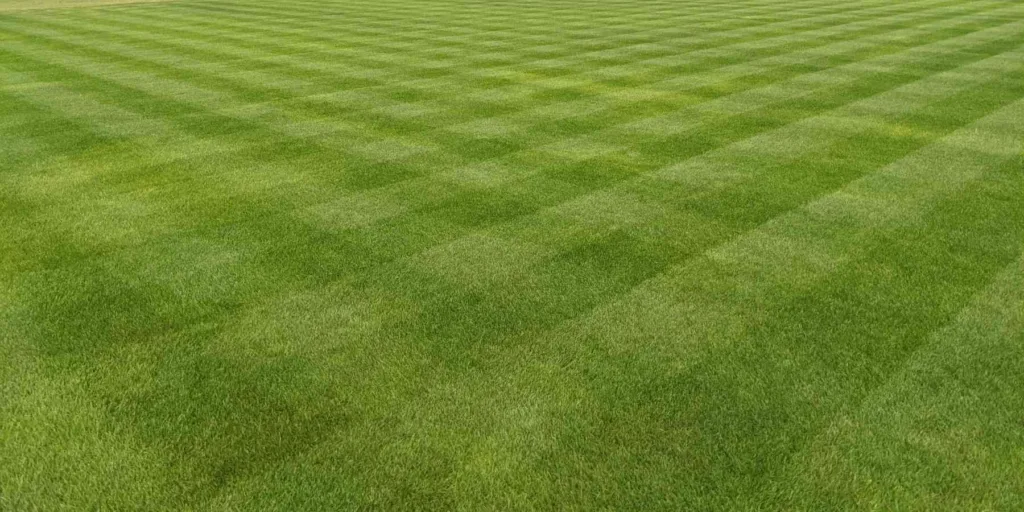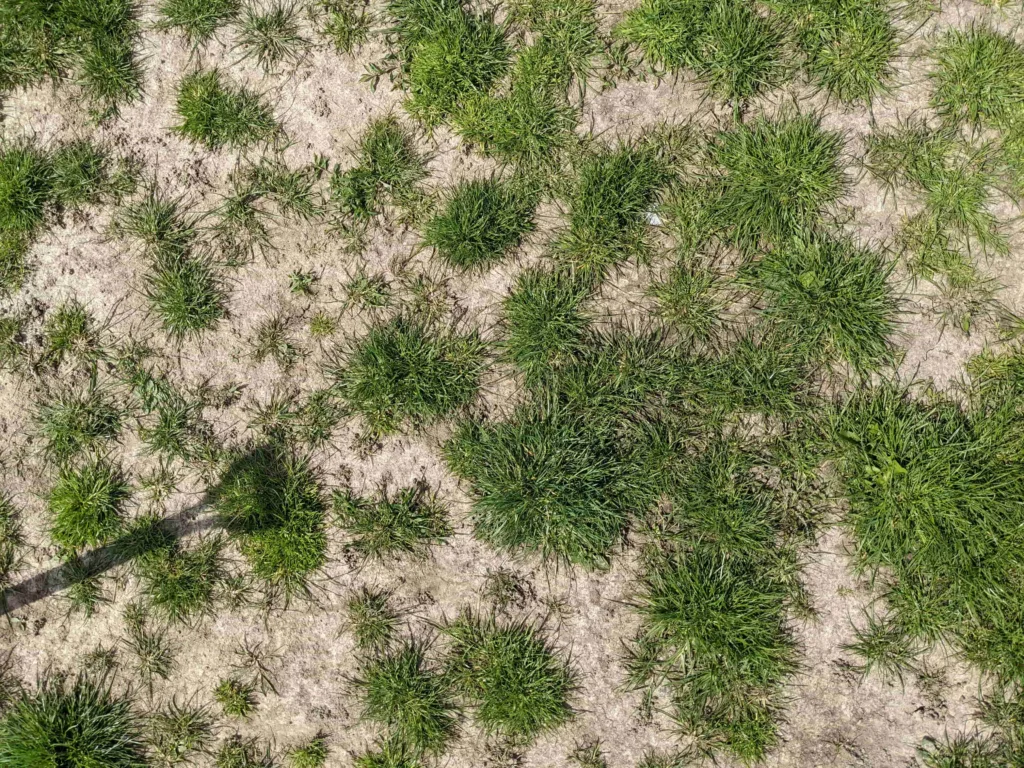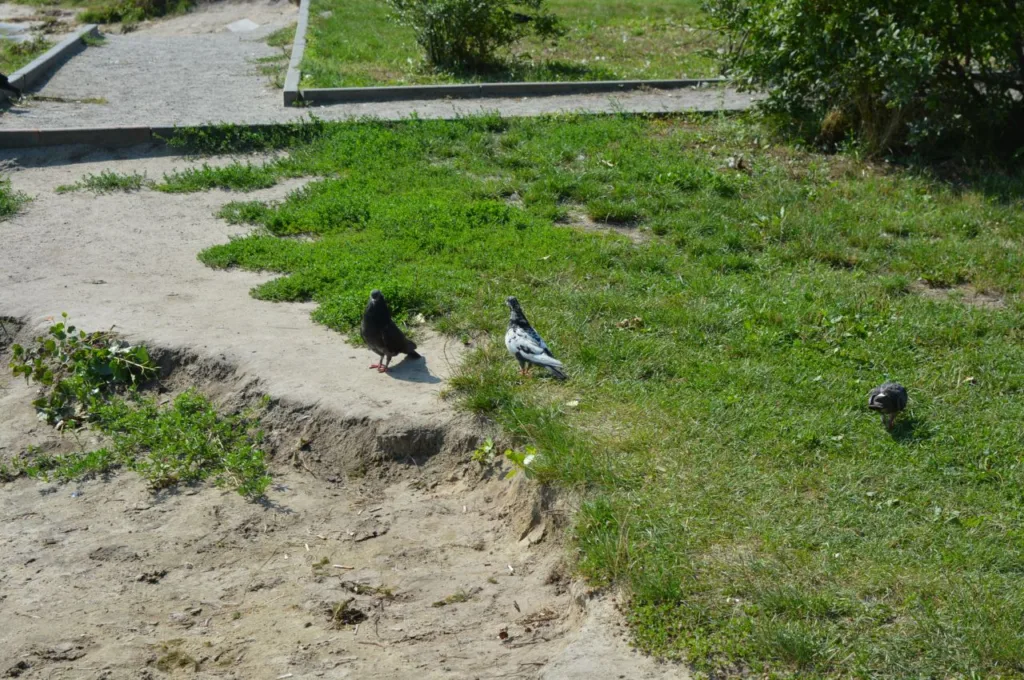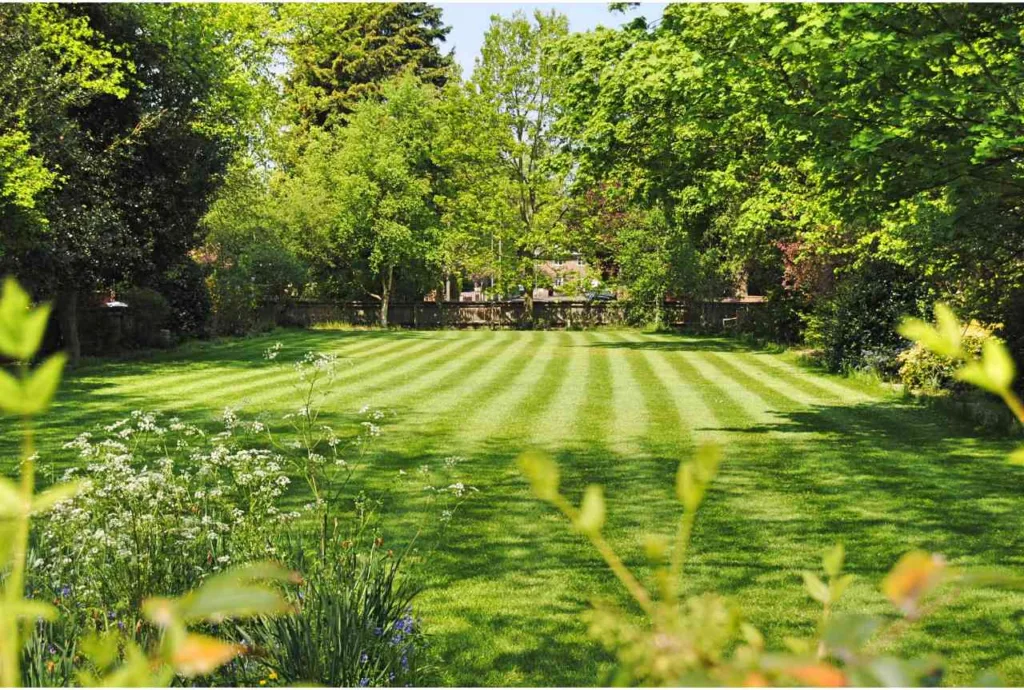Looking to overseed your lawn or establish a brand new lawn in the UK? You’re probably wondering which grass types are best for this situation.
As a turf expert and general lawn enthusiast, I’m in a good position to share my knowledge of the best types of lawn grass seed in the UK, and why. Find my recommendations below.
✅Key Takeaways:
The best grass seed types for UK lawns are:
Perennial ryegrass
Red fescue
Chewing fescue
Slender creeping red fescue
Tall fescue
Kentucky bluegrass (or smooth-stalked meadow grass)
Bentgrass
Table of Contents
🏆 7 Best Grass Seed Types For UK Lawns
In the UK, I’ve noticed that most manufacturers sell grass seed mixtures, which typically combine two or three carefully selected grass species. The types of grasses chosen in grass seed mixes sold in the UK are able to thrive in our relatively cool and rainy climate. That means they have certain characteristics that allow them to withstand our cold winters and high rainfall.
The 7 best grass types for UK lawns, which you’re most likely to come across when searching for UK grass seed, are as follows:
Perennial Ryegrass (Lolium Perenne)
My number one pick on this list, perennial ryegrass is the most popular choice for UK lawns due to its fine texture, rapid germination, and ability to quickly establish a lush, green lawn. I look for seed mixes with perennial ryegrass as one of the predominant lawn grasses because I know from experience that it has excellent wear tolerance, making it ideal for a hard-wearing lawn.
Red Fescue (Festuca Rubra)
Red fescue is another popular grass type because of its shade tolerance, making it suitable for lawns with tree cover or buildings casting shadows. I’ve found that red fescue forms a fine-textured, attractive lawn and contributes to the overall appearance of your lawn. It grows more slowly to begin with, so it’s often included in a grass seed mix with other faster-growing grass types.
Chewings Fescue (Festuca Rubra Commutata)
Chewings fescue is another fine-textured grass species that you’ll often find in seed mixes for UK lawns. It’s a UK favourite because of its ability to thrive in cool, damp conditions – something we’re certainly no stranger to in our corner of the planet.
Slender Creeping Red Fescue (Festuca Rubra Litoralis)
Slender creeping red fescue is another fescue variety that has a unique growing benefit: it spreads through rhizomes (horizontally growing underground stems), which helps it recover from damage and fill in bare spots in the lawn. It also has good drought tolerance – not an essential quality in a UK lawn grass species, but let’s not forget that we do tend to get an annual two-to-three-week heatwave nowadays.
Tall Fescue (Festuca Arundinacea)
This is the last of the fescue varieties that I recommend for UK lawns. Tall fescue is known for its robust growth, drought tolerance, and ability to withstand moderate wear and tear. It forms a deep-rooted, dense turf that’s both aesthetically pleasing and durable. Based on my experience with this grass, I think its versatility and low maintenance requirements make it ideal for good grass seed mixtures designed to create lush, attractive, and resilient lawns in the UK.
Kentucky Bluegrass (Poa Pratensis)
Kentucky bluegrass, otherwise known as smooth-stalked meadow grass, might sound like it’s a bit far from home, but it’s actually native to Europe and North Africa. It’s often found in smaller quantities (usually around 10-15%) in a premium grass seed mix and is known for its rich green color and fine texture. I’ve noticed that Kentucky bluegrass is capable when it comes to creating a dense, attractive lawn, but in my experience, it requires more maintenance and may need to be watered in the summer due to its shallow roots.
Bentgrass (Agrostis)
Bentgrass (sometimes referred to as bent grass) is commonly used on golf courses and bowling greens, but I have seen it used in seed mixes for ornamental lawns in the UK. It’s favoured for its fine texture and its tendency to low growth, giving it a desirable carpet-like appearance that looks great on manicured lawns. I wouldn’t personally recommend bentgrass in a seed mix for the everyday garden because it requires more frequent mowing to keep it looking its best.

🥇 Best Grass Seed Types For Specific Situations
Below, I’ve outlined the best types of grass seed to use based on different specific situations:
🌗 Lawns In Full Or Partial Shade: Red Fescue
For lawns in the UK with full or partial shade, my top recommendations for the best seed types are fine fescue grasses like red fescue, strong creeping red fescue, and chewings fescue. I’ve found that these grasses are ideal for use in shaded conditions because they thrive in areas with limited sunlight and retain their green color even in low-light conditions. If I had to pick one grass type only for shaded lawns, red fescue would be my number one pick.
🚦 High-Traffic Lawns: Perennial Ryegrass and Kentucky Bluegrass
My top recommended picks for a high-traffic family lawn in the UK are hard-wearing grasses such as perennial ryegrass and Kentucky bluegrass (otherwise called smooth-stalked meadowgrass). Perennial ryegrass is ideal for areas with frequent foot traffic because it has a strong root system and tough blades. Kentucky bluegrass forms a dense and resilient turf that can withstand heavy use, so it’s another great option for high-traffic lawns. My advice is to find a lawn seed mix that combines these grass species for the best results.

🚑 Lawns That Require Quick Repairs: Perennial Ryegrass
For making quick lawn repairs in the UK, I almost always recommend perennial ryegrass as the best choice because it’s quick to germinate and produces fast results, making it an excellent option for quickly filling in bare patches and repairing damaged areas. I’ve also found that this grass type blends seamlessly with existing grass – another reason why it works well for patching and repairing lawns.
⛱ Lawns In Coastal Areas: Slender Creeping Red Fescue
Slender creeping red fescue is my top recommended lawn grass for coastal areas because it’s one of the few UK grass types that’s tolerant to saline conditions. It’s usually combined with perennial ryegrass, which is moderately salt tolerant. Some sources also recommend seashore paspalum as a very salt-tolerant grass type, but unfortunately, as a warm-season grass, it’s not suitable for the UK climate.

🐶 Lawns With Pets: Perennial Ryegrass and Chewings Fescue
For lawns in the UK with pets, I recommend grass seed mixes that use a blend of hardy and wear-resistant grasses like perennial ryegrass and fine fescue varieties, like chewings fescue and creeping red fescue. Perennial ryegrass can handle paw traffic, and I’ve found that it recovers well from pet-related wear and tear. Fine fescues contribute to the lawn’s lush appearance and tolerance to shade. As a cat owner myself, I use a combination of chewings fescue and perennial ryegrass on my lawn.
👀 Ornamental Lawns: Bentgrass
My top recommendation for ornamental lawns in the UK is bentgrass due to its lush, manicured appearance and its fine texture that creates a carpet-like finish. The fine turf you see on golf greens is typically bentgrass, thanks to its ability to withstand short mowing and its dense, smooth growth. If your goal is to achieve a meticulously groomed and visually striking lawn, I think bentgrass is one of the best ornamental grasses to go for.

📑 Characteristics Of Grass Types Used For UK Lawns
Now we know the best types of lawn grass in the UK, I’ve compiled a list of all the features that many of these grass types have in common – the features that make them ideal for use in our country.
❄️ Cool-Season Variety
No surprise to you if you live in the UK: we don’t have a warm (or even mild) climate, and we need lawn grasses that can withstand our colder temperatures. Cool-season grasses like perennial ryegrass, red fescue, and chewings fescue are commonly used in the UK because they thrive in the cool, temperate climate.
🌒 Shade-Tolerant
Another well-known fact in the UK is that our gardens are small (in fact, they’re actually getting smaller). Some grass varieties used in the UK are shade-tolerant, to account for the fact that many of our smaller lawns have areas with partial shade due to trees and buildings.
✂️ Low Maintenance
Generally, even the garden-proud of us in the UK will admit that we don’t want to spend hours tending to our lawns. We’d prefer for our grass to maintain a green, lush appearance with no more maintenance than regular mowing. I’ve noticed that grass types used in UK lawns are often chosen for their ease of maintenance, requiring regular mowing and occasional fertilization at most.
💪 Versatility
Lawn grass needs to be able to check several boxes for most UK lawns. Not only do they need to be durable and frost-tolerant, but they must also withstand our warm, dry summers, have some level of shade tolerance, and be hardy enough to survive moderate traffic. Most lawn seed products in the UK are actually seed mixtures, which combine different grass species to provide a balance of characteristics.
🗓 Year-Round Greenness
Finally, the grasses used in UK lawn seed mixes tend to remain green throughout the year. Yes, they grow more slowly during the winter months, but they don’t go completely dormant. Of course, your grass’s greenness is determined by factors including how much sunlight and rainfall it gets and what type of summer we experience.
🏁 Final Word
I wrote this guide because I wanted to provide a clear, to-the-point reference guide to make it easy for anyone looking to seed a UK lawn to confidently choose the right seed type for their situation. If you’re ready to start shopping, you’ll find our guide to the best grass seed products in the UK a helpful read.
